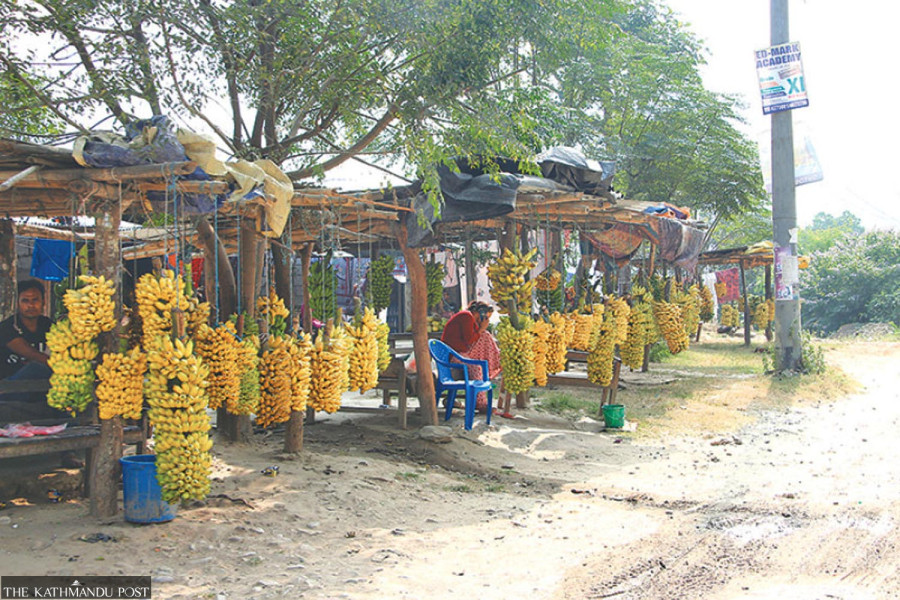Money
Nepal’s informal economy is 38.6 percent of GDP
Around 99.97 percent of real estate transactions are informal, study says.
Krishana Prasain
Nepal's informal sector is significantly large. It is estimated to be 38.6 percent of the country’s gross domestic product as of 2020-21, according to a research report released on Thursday. The informal economy represents Rs1.44 trillion in monetary terms.
The average size of the informal economy from 2010-11 to 2020-21 is 42.66 percent of the gross domestic product (GDP).
The research paper's authors said that the informal economy, which had been on a decline after the promulgation of Nepal’s Constitution in 2015, has started increasing after the Covid-19 pandemic.
Though the paper does not mention the size of the informal economy post-Covid, the researchers say that the nine-month-long import restrictions imposed from April 2022, the rise in bank interest rates and political instability, may have fuelled the informal economy.
According to the research report entitled Size of Informal Economy in Nepal, unveiled by the Central Department of Economics, Tribhuvan University on Thursday in collaboration with Nepal Rastra Bank, the share of the informal economy in GDP in 2010-11 was almost half at 49.1 percent.
It then gradually started declining and reached 42.9 percent in 2015-16.
In 2016-17, it dropped to 40.4 percent and further declined to 38.6 percent in 2017-18 and 37.6 in 2018-19.
In 2019-20, when the world, including Nepal, was hit by the deadly Covid-19 pandemic, the share of Nepal’s informal economy in GDP increased to 39.1 percent.
Shiva Raj Adhikari, chief of the Central Department of Economics, Tribhuvan University, and one of the researchers of the report said frequent changes in policy and unstable government fuel the informal economy. “We can see this trend,” he added.
Adhikari said that the informal economy is growing and its size is bigger in the least developed economies than in developed nations. The adverse effects of the informal economy are found to distort economic indicators, reduce tax receipts, and cause low productivity.
The informal enterprises play an important role in the economy, especially in terms of their contribution to job creation, but are part of the economy that is neither taxed nor monitored.
In addition, it also represents a sector with poor working conditions and an absence of social security.
As per the International Labour Organisation, globally about 2 billion workers, or 60 percent of the total employed population aged 15 years and older, operate in the informal sector.
The informal economy has important macroeconomic consequences, the International Monetary Fund says. First, informal firms tend to be small, with low productivity and do not contribute to the tax base. Therefore, countries or regions with higher informality also grow below their potential.
Moreover, they need to collect sufficient taxes and provide basic goods and services to the whole population, which reinforces informality.
Second, informal workers are more likely to be poor and to earn lower wages compared to their peers in the formal sector, both because they lack social protection and access to credit and tend to be less educated.
Third, women are more likely than men to be not only in informal employment but also in the most precarious and low-paying categories of informal employment, because they lack equal access to education and health services.
According to the report, agriculture, forestry, fishing, real estate activities and accommodation and food service activities have a high share in the informal economy.
The corresponding figures for other sectors are: 16.36 percent for manufacturing; 16.26 percent for construction; 14.99 percent for electricity, gas, steam and air conditioning supply; and 14.87 percent for wholesale and retail trade, and repair of motor vehicles.
Transportation and storage, followed by financial and insurance activity, information, and communication, has the lowest contribution to the informal economy, the report said.
The informal economy has a significant effect on economic and social development, national accounts, and public finance, the report said.
It also distorts the market, causing unequal production among the producers in the formal and underground economies.
“There is a sizeable prevalence of the informal economy in Nepal,” Adhikari said. Lately, the IT sector has emerged as one of the key contributing segments to the informal economy, which needs to be surveyed, he added.
However, the estimated size of Nepal's informal economy does not reflect the underground, black, hidden, or parallel economies. It largely indicates the unreported, underreported, or unrecorded economic activities the households produce for their final use.
The open border with India has also boosted the informal economy, especially after the 2022 imports restriction, said Adhikari.
Given that Nepal shares a 1,770-kilometre open border with India and that significant cross-border trades are informal, the report also recommends a look into how such informal transactions happen in the bordering areas.
According to the report, India’s demonetisation initiative in 2016 largely affected the Nepali economy since India is Nepal's important trading partner. The demonetisation in India may have had spillovers on the Nepali economy through trade and remittance channels.
“It is therefore highly likely that the demand for Nepali currency would have been largely affected by the demonetisation move by India,” according to the report.
According to the Economic Census 2018 of the Central Bureau of Statistics, which has been renamed National Statistics Office, 62.2 percent of the labour force in Nepal is engaged in the informal sector, with nearly 50 percent of total establishments unregistered.
The National Statistics Office report shows that 460,422 establishments, 49.9 percent of the total out of 923,027, are not registered.
That would not mean that the size of the informal economy is 49.9 percent.
However, this proportion of unregistered establishments may be taken as an upper-bound estimate of the size of the informal economy in Nepal, according to Thursday’s research report.
This story has been updated for clarity.




 5.83°C Kathmandu
5.83°C Kathmandu















